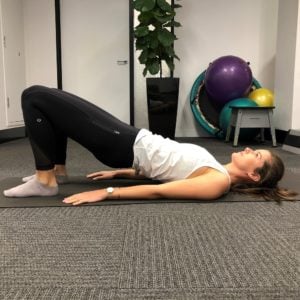In this blog we are going to add another exercise to the ‘Reformer Pilates vs Mat exercise’ blog series. This blog will talk about how bridging can be done on both the mat and on the reformer.
The set up
The set up of bridges involves laying on your back with your feet towards your hips, knees bent to 90 degrees. Your feet and knees should be hip distance apart. Before commencing the bridge it is helpful to start with pelvic tilts to bring some awareness to your spinal movements. Pelvic tilting involves tucking your tailbone and imprinting your lower spine (posterior tilt) and then opposing that movement by dropping your tailbone to the mat and arching your lower spine away from the bed (anterior tilt). Then hold the posterior tilt and start to lift your hips by lifting one back bone off the ground at a time. You should stop just before the end of your hip lift range. This prevents your lower spine going into end range extension which can sometimes be uncomfortable.
The Mat:
Bridging on the mat should target your gluteal muscle group (bottom muscles), in particular gluteus maximus. This is because the hips are lifting into extension, and the gluteus maximus is the muscle responsible for this movement. You will also get some spinal mobility from this bridging movement. If you are lifting one back bone at a time you will be opening up your spine as you roll up into the bridge. This spinal mobility is a good exercise to do in the morning if you feel stiff in your lower spine when you wake up.
Bridging on the reformer involves different muscle groups depending on which spring you are using. A heavier spring provides a more stable base of support and therefore will target the gluteal muscles. If the exercise is done on a lighter spring then the hamstrings will the more dominant muscle group. This is because a light spring makes the exercise challenging to keep the bed closed at the stopper. Knee flexion is the movement keeping the bed in closed and your hamstrings are the muscle group responsible for knee flexion.
This is just one example of an exercise which can be done on both the mat and reformer. Keep a look out on the Bend and Mend blog page to see some more mat vs reformer exercises.
If you would like a personalised Physiotherapy led exercise program using Pilates equipment come in for an Initial Assessment with one of our Bend + Mend Physios today.







